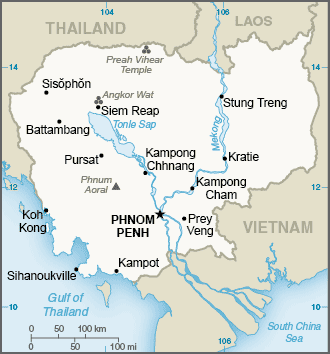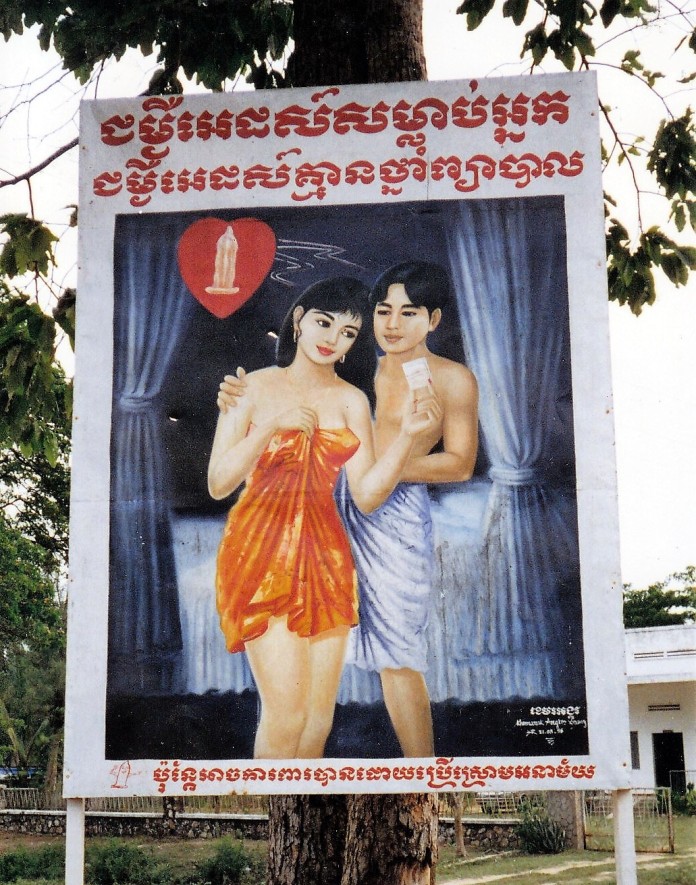December 1997: “Stretched out along the banks of the mighty Mekong, the weather in Phnom Penh is fantastic this time of year. Sunny and breezy, all is green following the rains. The mud-slide streets have dried up and the choking dust and oppressive heat won’t come into full force for another month or so. Most importantly, the city is quiet – for the time being at least. Some fighting resumed in the northwest of the country, but we are back to the calm after (or before?) the storm. One never knows what to expect in Cambodia!”

Civil War
During the months leading up to the fighting in July you could feel the increasing tension in the air. As usual, either utter doldrums of boredom in the blazing heat, with the usual annoyances, or life would suddenly get quite thrilling – as we listened intently for the steady bursting of shells. The situation was the worst it had been in some time.
The stalls in the local vegetable market were empty. My neighbor and I made a last dash to the nearby 7/7 shop and managed to score the few remaining basic food items and bottles of drinking water off the bare shelves before the owners closed the doors, locked the gate, loaded up their motorbike and headed out of town.
All but one of the banks had closed – and it was mobbed with people standing outside with bankbooks in hand watching the lucky ones in front receive hundreds, fifties, twenties, tens, fives, ones, and then, out of cash the bank simply closed its doors, leaving us all standing there with our worthless bankbooks.
Most of the foreign nationals were evacuated from the country. However, many of the international NGOs and United Nations staff remained during and after the fighting. It just so happened that both of my passports – diplomatic and USA national – were in government offices getting visas renewed when all this happened, so even if I could have left the country, I couldn’t travel anywhere. So we waited at home – shelling all day. My landlord’s family stayed too, and was wonderful with food and mutual support throughout.

One of the areas of heavy fighting was near the UNICEF office (and near my apartment!) Fortunately, the automatic weapons fire and heavy artillery were aimed away from my place. We were instructed to stay at home – I was literally under the bed and tuned to the two-way radio handset while the fighting swept by.
Others were not so fortunate. People were killed, and many homes and businesses were either destroyed by the fighting, or cleaned out by widespread looting by roving gangs of drunken young men toting AK 47’s. Many people fled to the countryside, and the deadly political purges followed. Sadly, just around the corner from the UNICEF office, two children were blown up by a hand grenade they found lying on the ground.

After the event, there was an overwhelming and pervasive feeling of depression. Jobs disappeared as foreign investors pulled out. All that had gone towards establishing some form of stability, law and order and a semblance of hope in Cambodia seemed lost.
Eventually, shops re-opened, and investment slowly trickled back into the country, but the economy remained weak. Tourism largely ground to a halt. So, if you were planning a visit to Cambodia, you would have the beautiful temples of Angkor all to yourself!
The international airport had also been significantly damaged by the fighting, and was closed for several days. Until repairs could be completed, it was prudent to schedule morning flights to Phnom Penh when the weather was more likely to be clear, because pilots had to rely on visual navigation only, to land at the international airport. When I eventually got my passports back, I had new visas that allowed me to stay in Cambodia for another year – a comforting thought!
The Mekong Region STD/HIV/AIDS Project
On top of all this Cambodia had the most serious and rapidly progressing HIV/AIDS epidemic in Asia, and was on the brink of becoming one of the worst affected countries in the world. HIV infection rates among sex workers, their clients and pregnant women were the highest in Asia. Nearly half of all brothel workers were infected, and the HIV infection rate among pregnant women had doubled since the previous year.

Commercial sex was cheap and widespread – an estimated 50,000 commercial sex contacts occurred each day in Phnom Penh, and with inconsistent condom use.

Under its humanitarian mandate, UNICEF was able to continue working for the benefit of women and children in Cambodia, including the training of over 10,000 primary and secondary school teachers and curriculum writers on Life Skills approaches for HIV/AIDS prevention, along with a learning package for foreign language schools.

UNICEF supported multi-sector prevention activities at provincial and local levels, as well as community-based care and counseling for people living with HIV/AIDS. One such activity, designated a UNAIDS “Best Practice” model, successfully brought together a dozen NGOs and the Buddhist temples in Phnom Penh in coordinated support of the municipal health services.
UNICEF also played a leading role in the first ever National Strategic Planning effort to identify priorities and key strategies to guide the response to the spread of HIV/AIDS in Cambodia.
Don’t Bring AIDS Back Home
UNICEF’s mass media social marketing campaign “Don’t Bring AIDS Back Home” had become the most popular HIV/AIDS prevention theme in Cambodia.
Cambodian women are especially vulnerable to HIV, in part due to cultural norms that tolerate men who seek sex outside of marriage and return home to have unprotected sex with their wives. Although the country’s epidemic was largely male-driven, it was increasingly infecting more women, with more than half of the new infections among women, and with implications for increased mother-to-child transmission of the virus.

Based on recent studies of sexuality among young people in Cambodia as well as our own participatory research with key target audiences, UNICEF worked closely with young people to produce appropriate IEC (Information, Education and Communication) media, including a series of interactive teaching video packages which presented real-life scenarios and modeled practical strategies for dealing successfully with a variety of risk situations.
Some of the videos were so popular, they were pirated and distributed even before being completed. These video packages were also adapted for use in Thailand, Laos and Vietnam.

Behavior modelling and Life Skills educational programs aimed to empower young people to deal effectively with their problems, make informed choices, act on their decisions and protect their health when pressured to take illegal drugs, engage in unprotected sex or participate in dangerous activities.
For example, working with adolescent boys hanging out at snooker clubs, and who also visit brothels, UNICEF staff helped them to identify a typical risk scenario, draft some basic scripting and even act in the video – which featured the peer group leader clearly modelling safer behavior at the brothel – in this case, insisting that they all use condoms.
Another scenario targets adolescent girls with example dialogue and behavior modelling to effectively and amicably delay the onset of sex, when pressured by their boyfriends.

Popular TV spots featuring famous Khmer actors also demonstrated safer behaviors. For example, married men who go out with their friends to drinking establishments where many of the waitresses or ‘beer girls’ also sell sex, are reminded to remain faithful to their wives or otherwise use a condom every time.
On one occasion, our popular film star ‘model citizen’ disappeared with the ‘beer girl’ actress after the TV spot filming was over. We could only hope they were using condoms!
Stay tuned for Part Three, coming soon!
You can read more about Jim’s backstory, here and here.

